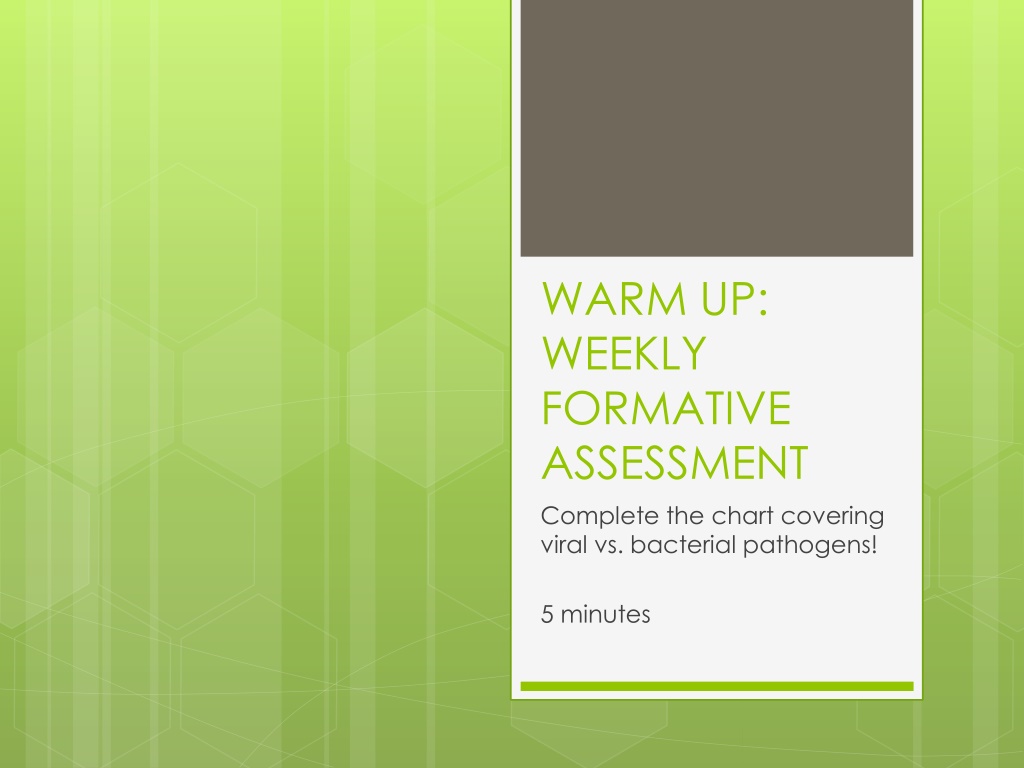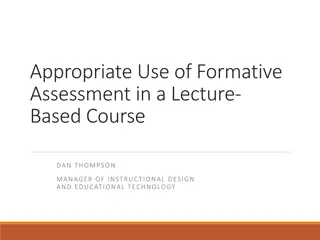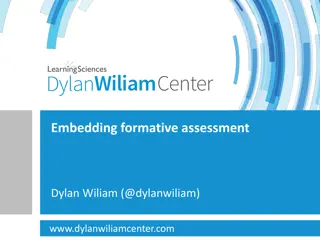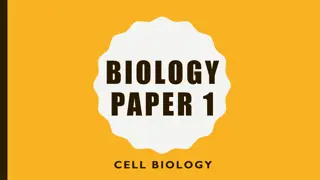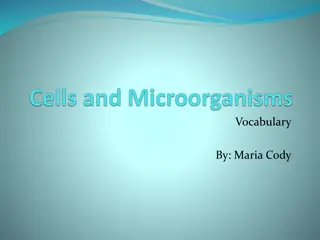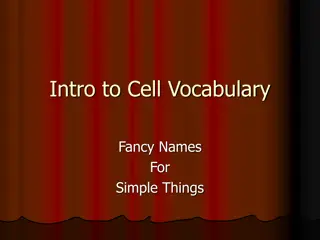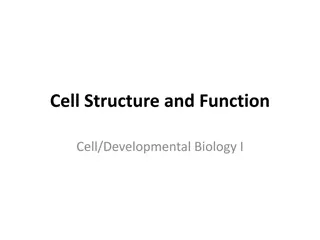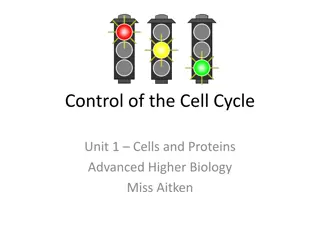Cell Biology Formative Assessment Activities
Engage students in interactive learning with a collection of formative assessment activities focusing on cell biology concepts such as viral vs. bacterial pathogens, homeostasis, cell membrane structure, and organelle functions. These hands-on tasks include predicting, labeling, and building cell components to reinforce understanding and retention of key topics in biology.
Uploaded on Oct 10, 2024 | 0 Views
Download Presentation

Please find below an Image/Link to download the presentation.
The content on the website is provided AS IS for your information and personal use only. It may not be sold, licensed, or shared on other websites without obtaining consent from the author.If you encounter any issues during the download, it is possible that the publisher has removed the file from their server.
You are allowed to download the files provided on this website for personal or commercial use, subject to the condition that they are used lawfully. All files are the property of their respective owners.
The content on the website is provided AS IS for your information and personal use only. It may not be sold, licensed, or shared on other websites without obtaining consent from the author.
E N D
Presentation Transcript
WARM UP: WEEKLY FORMATIVE ASSESSMENT Complete the chart covering viral vs. bacterial pathogens! 5 minutes
WHAT IS ONE CRITICAL THING THESE PEOPLE DO IN ORDER TO PLANK ON AN OBJECT?
CHECK THIS OUT!!! THESE PEOPLE ARE CRAZY! http://youtu.be/tRHnTFesv7c
PLANKING: An act of BALANCING your body on any given object. *You must keep your arms down to your sides and your head down.
Raise your hand. Predict what you think HOMEOSTASIS means for a cell.
Look at your notebooks Which ORGANELLE is responsible for maintaining homeostasis?!! (hint: it does this by controlling what enters and leaves the cell)
What if I told you You are made of mostly water! IN and OUT of your cells is water-based. The cell membrane has both water- LOVING and water-FEARING properties so it must be shaped a certain way!
Today we are building a cell (plasma) membrane! Cut and organize the pieces of the cell membrane in the placement you predict. Put it in the MIDDLE of the notebook, across two pages: 30-31 DON T GLUE YET! HINT: THE WATER-FEARING PARTS WILL FACE EACH OTHER!
Fluid surrounds the membrane. Label INTRACELLULAR and EXTRACELLULAR . What side of the membrane do you predict the organelles to go? DRAW and LABEL these organelles where they belong: nucleus, ribosomes, mitochondria
Fluid surrounds the membrane. If AQUEOUS means made of mostly WATER Which part of the cell should be AQUEOUS, inside or outside the cell? Or both? LABEL AQUEOUS (WATER-BASED) ENVIRONMENT where it belongs!
ANd9GcTEblYxlBFwx4D7YOJVz6uCmmdfBBMjtj6cofPGsBaNRmZPd9chgrZk7B4ANd9GcTEblYxlBFwx4D7YOJVz6uCmmdfBBMjtj6cofPGsBaNRmZPd9chgrZk7B4 ANd9GcTEblYxlBFwx4D7YOJVz6uCmmdfBBMjtj6cofPGsBaNRmZPd9chgrZk7B4 So We talked about digestion last six weeks. After the polymers get broken down into monomers in the digestive system ..What happens to these molecules after they are absorbed? Where do these molecules go? They travel the blood stream and enter our cells
ANd9GcTls7He8XzAq0_FBJdKsTbD7eCFVf8xgkg3WZKCWkTAODTv1PXEoRPylxEANd9GcTls7He8XzAq0_FBJdKsTbD7eCFVf8xgkg3WZKCWkTAODTv1PXEoRPylxE ANd9GcRrzxApYkE1O3_a81PmQGzTr-KojtVgMJSrLgUHInbA6zC5l-pl4hE_Ow ANd9GcSYFf3v08lvZDwqtHhMxhDa28FEngtDGBDzLSgGQA77FxSPYl3qeurvFcs ANd9GcSH3CfEgtdHw3hqjoEtSC6HfrkTkgVjhVHVAhgFxJjQkYYCvPVAlx9pDQ small intestinal Villi absorbs into to the blood ANd9GcR1RVJ1xmOgxxM2X0WFMPLrJSWZTxFiu_CmKuPIhluRBNzm8QHSyUjoZoc HOW DO THEY GET INTO OUR CELLS?!
Cell transport Every multi-cellular organism is made of specialized cells (Red blood cells, muscle cells, nerve cells) Each cell must perform an important life function Extremely The cell membrane is important. The cell membrane will allow things to enter and leave the cell. This is called CELL TRANSPORT.
This is where homeostasis plays a role ANd9GcSQgDSOukw5Xa_nJd_DcuUEbXT1cDHJRrnYlmWRQYLuv8LXUd3cBtrtOSY
Have you ever wondered why your dog pants on hot days? It's because your dog is trying to maintain homeostasis. ANd9GcRNMb0X2xQMGNjUJ2dHcXK277yCuoJ9t_9ha-acGbk9YyKrrloDWsMOHks ANd9GcS700-8fYisc3dpLfPE7iGwydiGwIK2GA8STMR-YgwLH4K8yGDXu7nuIG8 Homeostasis is a word used to describe how a living organism regulates its internal environment to maintain stability (equilibrium = balance).
How do living things maintain homeostasis? ANd9GcTPk6NRYZ1Y0sY4a9hyv_7hcQ4LV6aRx5YwfXAzj4UeI_7tFAhzJeRjYdZX When your body temperature begins to rise, what happens? *You begin to sweat. *Sweating is your body's way of cooling down = Homeostasis
Dogs.. do not have sweat glands SO they pant. Dogs have just a few sweat glands in their paws, so no matter how much they sweat; sweating could never cool them off. That's where the tongue-hanging out, mouth- open dog panting comes in. ANd9GcQMcBf47H6uWeFL73kRLd7DcVTme1XMzgd6iTUwMoslo9r9Ir9fm1jEhlc They are maintaining balance
ANd9GcSxn9lZCq4FH0spQZkjq_Cdm-VpQgArxqK6UkQRJvLouU5TjsO3Nmg2NL8ANd9GcSxn9lZCq4FH0spQZkjq_Cdm-VpQgArxqK6UkQRJvLouU5TjsO3Nmg2NL8 Cell Membrane characteristics: The cell (plasma) membrane regulates what enters and leaves the cell (like a body guard) It is responsible for maintaining homeostasis in that way. There are a few ways to describe the membrane: phospholipid bilayer semi permeable Fluid mosaic model ANd9GcR28ZRXcbhv9gGGUXch-j6_2MzzQvWJ3mt7iZox2jYl_jinKrPki8bUUQ
Cell Membrane characteristics: phospholipid bilayer : the membrane is composed of TWO layers of phospholipids, forming a bilayer. The tails face each other. semi (selectively) permeable: the membrane only allows certain particles to pass through, not others. Fluid mosaic model: the membrane looks fluid-like because it is flexible.
What is a PHOSPHOLIPID? A lipid molecule with a PHOSPHATE head and TWO FATTY ACID tails. The phosphate heads are HYDROPHILIC and love water. The fatty acid tails are HYDROPHOBIC and hate water, so they face each other when forming the layer! On your membrane, LABEL: THE PHOSPHATE HEADS FATTY ACID TAILS Hydrophilic zone hydrophobic zone
Label your cell membrane! Carbohydrate chains Proteins Phospholipids Protein channel Lipid bilayer
What molecules are the cell membrane composed of? ANd9GcRvgRhDEpFhy83jsMpbSLSmVP9UP_JnrTDA1CyXxzFHa7VX6TE-iH_Alg * Proteins Aid in transport * Phospholipids make up the double layer *Surface carbohydrates allow for cell recognition & signaling ANd9GcQTOGwEHcPYMH0rBpCekd2t853a5yT0WhFKuQFiG7-5gPgo1jZhvVbwFLkw
